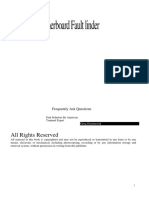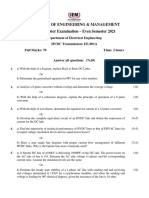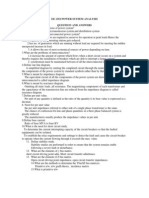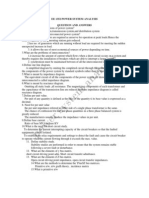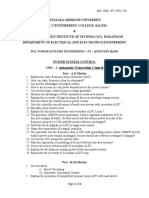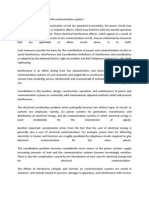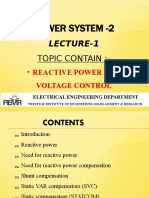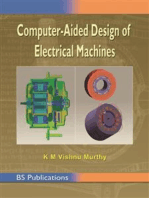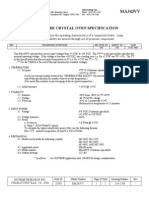Important Questions - APS - I
Important Questions - APS - I
Uploaded by
Aakash MehtaCopyright:
Available Formats
Important Questions - APS - I
Important Questions - APS - I
Uploaded by
Aakash MehtaOriginal Description:
Original Title
Copyright
Available Formats
Share this document
Did you find this document useful?
Is this content inappropriate?
Copyright:
Available Formats
Important Questions - APS - I
Important Questions - APS - I
Uploaded by
Aakash MehtaCopyright:
Available Formats
ADVANCED POWER SYSTEM - I
Classify FACTS devices and explain any one in detail. Discuss advantages of FACTS. What are the advantages offered by FACTS devices? What are the emerging trends in transmission networks? Explain UPFC control with neat schematic diagram. Explain different methods of Reactive power control. Discuss in brief various sources and sinks of reactive power in power system. Explain conventional methods of real power control in the transmission line. For a lossless distributed parameter symmetrical line, derive the equation for the midpoint voltage on the line in terms of wave number and surge impedance of the line. Also draw graph for the voltage distribution, midpoint voltage v and load angle . What is the requirement of reactive power in a transmission system? Compare series and shunt compensation. What is meant by compensation? Discuss shunt and series compensation in power system. Explain load compensation and system compensation with the help of phasor diagram. Give general characteristics of static var compensator. Give configuration and application of synchronous condensers. Explain construction and operating characteristics of saturated reactor with neat diagram. What is AGC? How primary and secondary control in AGC works? Also explain transformer tap changer control. What is synchronous condenser? What are its applications? Compare synchronous condenser and static capacitor for reactive power compensation. Explain working of STATCOM with schematic diagram. Explain conventional methods of reactive power control in the transmission line. Sketch and explain characteristics of an ideal & realistic Static VAR System(SVS). Compare different SVCs. Explain modeling of thyristor controlled reactor (TCR) in details with necessary expressions and usual notations. Explain operating characteristics of thyristor controlled reactor (TCR). What is TSC-TCR? How can it be differentiated from FC-TCR? Explain operating characteristics of TSC-TCR. Explain operating characteristics of FC-TCR. Explain about Mechanically Switched Capacitor-Thyristor-Controlled Reactor(MSCTCR). Sketch basic single phase unit and three phase unit of thyristor switched capacitor (TSC). Explain how TSC improves voltage profile in power system with the help of its characteristics. Discuss in brief: (i) Different types of HVDC links (ii) Equipments for a typical HVDC transmission scheme. State advantages of HVDC transmission over EHVAC transmission for bulk power transmission. Compare EHVAC and HVDC transmission system. What are the standard rated voltages for HVDC and EHVAC systems?
Explain schematic diagram of HVDC substation and explain working of each component in brief. What are the equipments required in HVDC system? Discuss the reliability aspect of HVDC system. What are the requirements of an ideal control system for HVDC link? Draw and explain the diagram of hierarchical control scheme for a HVDC link. Compare HVDC power transmission with current source converter (CSC) and voltage source converter (VSC). Prove that power transmitted by bipolar DC line is same as that of 3 phase AC line with necessary assumptions. Explain working of TCR. Draw wave forms of voltage and current for different values of . Develop the complete equivalent circuit of an HVDC link and obtain an expression for the current in the DC link as
Analyze 12-pulse converter. Sketch the current waveform of the transformer secondary line current of a 12 pulse converter. Derive expressions for PIV and PPR for 12 pulse converter. Give schematic diagram of 12 pulse converter. Explain different conduction modes. Explain conduction sequence in 6-pulse converter configuration used for HVDC system. For 6-pulse converter, derive equivalent circuit for rectifier and inverter for an HVDC power transmission system with usual expressions. Obtain the expression for PIV, peak-to-peak ripple and valve volt-ampere rating in a 6-pulse Graetzs converter circuit. How compounding of rectifiers can be done? Explain current compounding of an inverter. What is the principle of HVDC voltage source converter? Explain in detail with relevant diagrams. What is a HVDC-VSC system? Give single line diagram of the system. Write comparison between the classical HVDC and HVDC-VSC system. Derive the equations for power flow in an HVDC link. How are the losses estimated? What is IGBT? Draw its symbol and discuss important features of IGBT. List reason for selection of IGBT for VSC based HVDC conversion. Explain the turn-on/turn-off mechanism with series connected IGBTs. Give the typical on/off voltage and current waveforms. What is the importance of harmonic study in HVDC system? How the harmonics are generated by transformers and converters? Write a short note on causes and consequences of harmonics in HVDC system. Identify the various sources for generation of harmonics in HVDC system. Discuss various adverse effects caused due to the presence of harmonics. State the important basic controls required for the operation of HVDC systems and explain how they work and maintain system stability under abnormal conditions. Explain about Inverter Extinction Angle Control (EAG). What are its limitations under asymmetrical fault? Give a neat diagram of the basic control system for HVDC converters and explain various controls incorporated in the system.
Distinguish between delay in firing angle() and extinction angle() of an HVDC converter. Explain the operation a converter when working as an inverter, and state the necessary conditions required for inverter operation. With relevant diagram explain operation of IPC schemes employed in control schemes of firing circuit of HVDC station. Explain operation of cosine control of phase delay used in above schemes. State differences in power control in HVDC and HVAC system. Explain the necessity of power control in an HVDC link. Show that in a 3-phase bridge rectifier operating with no delay and with 60 overlap, the direct current is one-half of the crest value of line-to-line short circuit on the secondary side of the transformer bank. An existing 400 kV, 3-phase AC line transmitting power of 100 MW is converted into bipolar DC line. Compute the DC voltage per pole and DC line loss in kW if the resistance of each conductor is 0.01 . Assume power factor of 0.9 lagging. Also comment on the insulation to be provided for DC line in comparison with that of AC line. If Vg-Ig characteristics of an SCR is assumed to be a straight line passing through the origin, with a gradient of 3*10+3. Calculate the required gate source resistance, given that Eg = 10V and allowable gate power dissipation is 0.012W. A bipolar two terminal HVDC link is delivering 1000 MW at 500 kV at the receiving end. The total losses in the DC circuit are 50 MW. Calculate the following: (i) Sending end power (ii) Sending end voltage (iii) Power in the middle of the line (iv) Voltage in the middle of the line (v) Total resistance of the DC circuit A 500 kV, 2000 MW HVDC converter operates as a 12-pulse unit. Assuming full conduction and no losses, calculate (i) Transformer secondary line to line voltage(rms) (ii) Peak to peak ripple (iii) PIV of the valves and (iv) Transformer line current. An HVDC bipolar link using 6-pulse converter is supplying power of 500 MW at 100 kV. The rectifier station is working at a delay angle = 15. Estimate (a) No-load DC voltage, (b) AC voltage on the converter side of the transformer, (c) Transformer secondary rating, (d) Peak inverse voltage, (e) Peak-to-peak ripple and (f) Current on the secondary side of the converter transformer. An HVDC link delivers DC power with AC line voltage to the rectifier being 230 kV and that at the inverter being 220 kV. The current order of the rectifier is 1000 A and that of the inverter is 900 A. Estimate the delay/extinction angle of the rectifier/inverter when the DC voltage at the inverter end is 250 kV. Assume the DC resistance of the line as 20 . Calculate the secondary line voltage of the transformer 3-phase bridge rectifier to provide a DC voltage of 100kV. Assume = 30 and =15. What is effective reactance XL, if the rectifier gives 600A of DC output current?
You might also like
- Macbook Repair Guide Repair Case v1Document249 pagesMacbook Repair Guide Repair Case v1Rodrigo Policena Bocatto100% (7)
- BOOK Laptop Motherboard Fault FinderDocument85 pagesBOOK Laptop Motherboard Fault FinderServis Accu83% (6)
- SUBJECT: Elective-I Flexible A.C. Transmission Systems (FACTS) Question Bank Unit-I:Introduction To FactsDocument4 pagesSUBJECT: Elective-I Flexible A.C. Transmission Systems (FACTS) Question Bank Unit-I:Introduction To FactsJagadish Babu KondraguntaNo ratings yet
- PE LessonPlanDocument4 pagesPE LessonPlanNarasimman DonNo ratings yet
- FinalDocument2 pagesFinalgobinathNo ratings yet
- AC Lines SVS CompensationDocument8 pagesAC Lines SVS CompensationSagar ThakerNo ratings yet
- Prist University: Question BankDocument7 pagesPrist University: Question BankJhon LouisNo ratings yet
- VSC-FACTS-HVDC: Analysis, Modelling and Simulation in Power GridsFrom EverandVSC-FACTS-HVDC: Analysis, Modelling and Simulation in Power GridsNo ratings yet
- Facts QuestionsbankDocument7 pagesFacts Questionsbankjaackson10No ratings yet
- Unified Power Flow ControlDocument9 pagesUnified Power Flow ControlpavanNo ratings yet
- FACTS Question BankDocument7 pagesFACTS Question BankAnbarasan AnnamalaiNo ratings yet
- Institute of Engineering & Management Mid Semester Examination - Even Semester 2021Document2 pagesInstitute of Engineering & Management Mid Semester Examination - Even Semester 2021Workaholic KidNo ratings yet
- 2 Marks and 16 MarksDocument34 pages2 Marks and 16 Marksanandarao7362No ratings yet
- Question Bank: EighthDocument7 pagesQuestion Bank: EighthprakashNo ratings yet
- Facts 3Document14 pagesFacts 3gjk1236596100% (1)
- Ee2036 - Flexible Ac Transmission System: 2 Marks and 16 Marks-Question BankDocument27 pagesEe2036 - Flexible Ac Transmission System: 2 Marks and 16 Marks-Question Bankgunasekaran RajendranNo ratings yet
- Compensation Techniques in AC Transmission System Using CDocument33 pagesCompensation Techniques in AC Transmission System Using CSaleem KhanNo ratings yet
- Ee 1352 Power System Analysis Question and AnswersDocument7 pagesEe 1352 Power System Analysis Question and AnswersSandhosh RajaNo ratings yet
- Real and Reactive Power Flow Control With Upfcconnected To A Transmission LineDocument7 pagesReal and Reactive Power Flow Control With Upfcconnected To A Transmission LineSravan GuptaNo ratings yet
- Flexible AC Transmission SystemsDocument51 pagesFlexible AC Transmission SystemsPriyanka VedulaNo ratings yet
- Ee 1352 Power System Analysis Question and AnswersDocument7 pagesEe 1352 Power System Analysis Question and AnswerssukeshsrkNo ratings yet
- Department of Eee Question Bank: Sub Code: Ee1004 Sub Name: Power System Transients Year: Iv SEM: ViiiDocument8 pagesDepartment of Eee Question Bank: Sub Code: Ee1004 Sub Name: Power System Transients Year: Iv SEM: Viiiqais652002No ratings yet
- EE2351 PSA 2marks 2013 - 2Document15 pagesEE2351 PSA 2marks 2013 - 2Vijay RajuNo ratings yet
- Review Paper On FACTS DevicesDocument18 pagesReview Paper On FACTS DevicesBakhtiar Khan100% (1)
- Question and AnswersDocument46 pagesQuestion and AnswersKumaranNo ratings yet
- JCT College of Engineering and Technology: Pichanur, Coimbatore-641105, India ISO 9001:2008 Certified InstitutionDocument16 pagesJCT College of Engineering and Technology: Pichanur, Coimbatore-641105, India ISO 9001:2008 Certified InstitutionPrakash Chandran CNo ratings yet
- Power System Control-1Document6 pagesPower System Control-1Venkatesh KumarNo ratings yet
- Ee 328 Lecture 1Document40 pagesEe 328 Lecture 1Hasan Hatice IlcalıNo ratings yet
- Power Quality-Model QPDocument3 pagesPower Quality-Model QPKarthick GuberanNo ratings yet
- MCQDocument41 pagesMCQLakshmi Narayanan100% (1)
- Gujarat Technological UniversityDocument1 pageGujarat Technological UniversityChintan PatelNo ratings yet
- Facts 2 MarksDocument14 pagesFacts 2 MarksBharath Raj100% (1)
- T&DDocument5 pagesT&DMATHANKUMAR.SNo ratings yet
- Sri Jayachamarajendra College of EngineeringDocument13 pagesSri Jayachamarajendra College of EngineeringFernando Desengkie SangmaNo ratings yet
- Elective IV-flexible Ac Transmission SystemDocument10 pagesElective IV-flexible Ac Transmission SystemMATHANKUMAR.S0% (1)
- Subject Code: Ee 1005 Subject Name: Power Quality: What Are The Causes Due To Short Circuit in TheDocument22 pagesSubject Code: Ee 1005 Subject Name: Power Quality: What Are The Causes Due To Short Circuit in TheChetan KotwalNo ratings yet
- Unit-6 Circuit Breakers (Switchgear and Protection)Document84 pagesUnit-6 Circuit Breakers (Switchgear and Protection)sujithNo ratings yet
- EE2036 2 MarksDocument19 pagesEE2036 2 MarksSaravanan RameshNo ratings yet
- Interference of Power Line With Communication SystemDocument4 pagesInterference of Power Line With Communication SystemUsama Shafqat0% (1)
- Presentation On UPFC ControllerDocument18 pagesPresentation On UPFC ControllerTesfahun GirmaNo ratings yet
- Eee-Vi-Power System Analysis and Stability (10ee61) - Notes PDFDocument119 pagesEee-Vi-Power System Analysis and Stability (10ee61) - Notes PDFLatisha CarterNo ratings yet
- 2nd Mid Assingnment QuestionsDocument3 pages2nd Mid Assingnment QuestionsSatya TejaNo ratings yet
- Transient Recovery VoltageDocument4 pagesTransient Recovery VoltageKanai BanerjeeNo ratings yet
- Static VAR Compensation (SVC)Document2 pagesStatic VAR Compensation (SVC)Vedant KulkarniNo ratings yet
- Introduction To FACTS: Alternating Current Transmission System (FACTS) Devices in Power Grids. FACTS AllowDocument4 pagesIntroduction To FACTS: Alternating Current Transmission System (FACTS) Devices in Power Grids. FACTS AllowsameekshaNo ratings yet
- M.g.say ch01Document5 pagesM.g.say ch01prabhjot singh150% (2)
- Power System2Document15 pagesPower System2Aayush PatidarNo ratings yet
- PQE 2 MarksDocument8 pagesPQE 2 MarksfvijayamiNo ratings yet
- Electrical Live - Power SystemDocument27 pagesElectrical Live - Power SystemashishNo ratings yet
- Flexible AC Transmission System Using TSR1517102818Document2 pagesFlexible AC Transmission System Using TSR1517102818Anil Reddy0% (1)
- Ge2151 QBDocument7 pagesGe2151 QBparthi3986No ratings yet
- Flexible AC Transmission SystemDocument5 pagesFlexible AC Transmission SystemAliq FazliNo ratings yet
- Unit 2 FactsDocument5 pagesUnit 2 FactsHarris RajNo ratings yet
- Three Phase Fault Analysis With Auto Reset Technology On Temporary Fault or Remain Tripped OtherwiseDocument4 pagesThree Phase Fault Analysis With Auto Reset Technology On Temporary Fault or Remain Tripped OtherwisePritesh Singh50% (2)
- R o Y o B oDocument6 pagesR o Y o B oloffycrazeNo ratings yet
- Power Quality 2 Marks and 16 MarksDocument6 pagesPower Quality 2 Marks and 16 MarksBala MuruganNo ratings yet
- EE1401 POWER SYSTEM OPERATION AND CONTROL - Two Marks Questions and Answer & QBDocument16 pagesEE1401 POWER SYSTEM OPERATION AND CONTROL - Two Marks Questions and Answer & QBAmruthNo ratings yet
- Ee 1351 Power System AnalysisDocument31 pagesEe 1351 Power System AnalysisStephen Kenth La GuerreNo ratings yet
- Chapter 3Document11 pagesChapter 3nikhilNo ratings yet
- Simulation Analog Input and Output Programming in Simatic S7-PLCSimDocument13 pagesSimulation Analog Input and Output Programming in Simatic S7-PLCSimKhaled OuniNo ratings yet
- Aspire R3 471T Quanta ZQX DDR3Document43 pagesAspire R3 471T Quanta ZQX DDR3Luciano LucasNo ratings yet
- 300 Level Alternativev To PracticalDocument6 pages300 Level Alternativev To PracticalDjNo ratings yet
- Brosur Ajex 2000 HMDocument2 pagesBrosur Ajex 2000 HMDedi SuryantoNo ratings yet
- All-Test Pro, LLC: 25 HP Inverter Grade MotorDocument2 pagesAll-Test Pro, LLC: 25 HP Inverter Grade MotorRM HaroonNo ratings yet
- Specification For Transformer: ANSI C57.12-01Document1 pageSpecification For Transformer: ANSI C57.12-01Charlie MendozaNo ratings yet
- File 20221216 204443 File 20220324 140938 Xew02-NewDocument1 pageFile 20221216 204443 File 20220324 140938 Xew02-NewVũ Công TuyềnNo ratings yet
- Acomel 5000 User ManiualDocument24 pagesAcomel 5000 User ManiualFlorin PetrilaNo ratings yet
- Control Remoto Universal GE Modelo RM94927-F MANUAL000036754Document44 pagesControl Remoto Universal GE Modelo RM94927-F MANUAL000036754Douglas FerrerNo ratings yet
- LG Flatron M2080D PDFDocument156 pagesLG Flatron M2080D PDFAntonio HinojosaNo ratings yet
- Introduction, Methology and Front Page Lab Report Sem2Document3 pagesIntroduction, Methology and Front Page Lab Report Sem2ammar tajuddinNo ratings yet
- Major Project List of VEGA KITDocument4 pagesMajor Project List of VEGA KITpreetish1234No ratings yet
- Pioneer Deh-2950mp Crt3820Document70 pagesPioneer Deh-2950mp Crt3820Lasertech Módulos100% (1)
- Varactor SPICE ModelsDocument5 pagesVaractor SPICE ModelsswatagodaNo ratings yet
- Ina 168Document15 pagesIna 168Ernane FreitasNo ratings yet
- Stick Reader EVO - UHFDocument2 pagesStick Reader EVO - UHFr_simoesNo ratings yet
- PLC Based Motor Control Using VFD: by VP-Engineering, Industrial Controls Corp. Chairman, MRSPDocument28 pagesPLC Based Motor Control Using VFD: by VP-Engineering, Industrial Controls Corp. Chairman, MRSPSun TzuNo ratings yet
- Virtual InstrumentationDocument49 pagesVirtual InstrumentationVijaya LakshmiNo ratings yet
- 600 Watt Grid Tie Inverter: Technical DataDocument1 page600 Watt Grid Tie Inverter: Technical DataJodi SetiawanNo ratings yet
- EIT - Infosys MaterialDocument54 pagesEIT - Infosys MaterialAnkeet PandaNo ratings yet
- L02 MSP430Document34 pagesL02 MSP430Srinivas VN100% (1)
- EE 215 - Laboratory 3 - Operational Amplifiers (Op Amps) : AuthorsDocument5 pagesEE 215 - Laboratory 3 - Operational Amplifiers (Op Amps) : AuthorsÁo Đen0% (1)
- SPC1 Single Phase Power Controller PDFDocument6 pagesSPC1 Single Phase Power Controller PDFMin ZayarNo ratings yet
- Prolific Systems & Technologies Pvt. LTD.Document77 pagesProlific Systems & Technologies Pvt. LTD.Mystic AamirNo ratings yet
- Chap 1Document7 pagesChap 1Serge RINAUDONo ratings yet
- Miniature Crystal Oven Specification: Maj43VvDocument3 pagesMiniature Crystal Oven Specification: Maj43Vvsnewton6752No ratings yet
- HT140WXB-501 Product Specification Rev. 0: Beijing Boe Optoelectronics TechnologyDocument36 pagesHT140WXB-501 Product Specification Rev. 0: Beijing Boe Optoelectronics TechnologyichsanNo ratings yet


